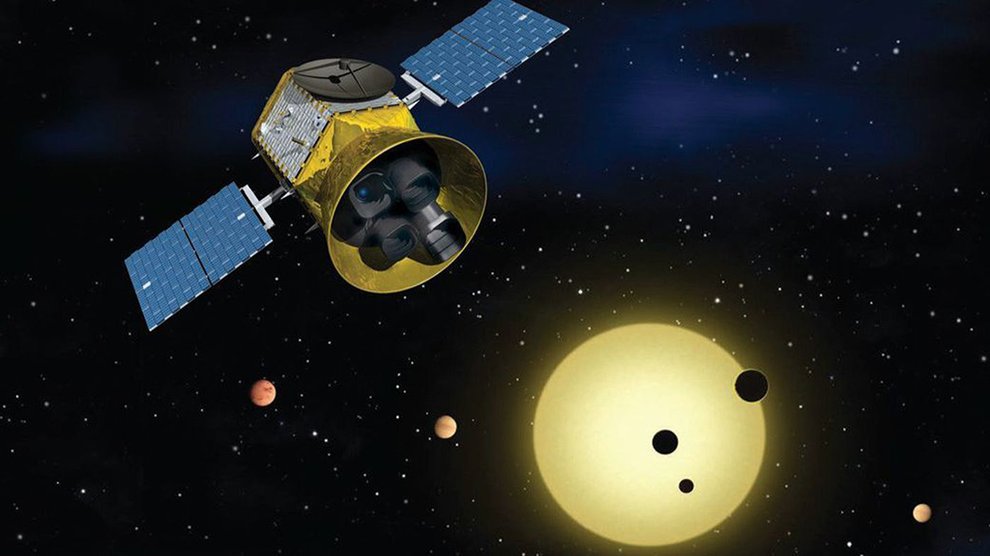Watch TESS launch LIVE at the embedded NASA stream below.
The era of big data is here—not just for life on Earth, but in our quest to find Earth-like worlds, too.
Next Monday, April 16, NASA’s $200-million Transiting Exoplanet Survey Satellite , or TESS , will surge skyward on a SpaceX Falcon 9 rocket. If all goes well, over the next two years, it will search space for signs of exoplanets , or planets beyond our own solar system. So far, scientists have found around 4,000 such celestial bodies freckled across the face of the universe, including seven Earth-sized planets orbiting the dwarf star Trappist-1 about 235 trillion miles away. NASA’s Kepler spacecraft, launched in 2009, has led this revolutionary effort—but now it’s running out of fuel.

TESS, its replacement, will document close-by exoplanets circling bright stars (as opposed to the more distant ones Kepler surveyed). These data points will give scientists more information about the planets ripest for scientific exploration—and which may harbor life.
“TESS’s job is to find an old-fashioned address book of all the planets spread out around all the stars in the sky,” said Sara Seager, astrophysicist and planetary scientist at MIT and deputy science director for the TESS mission.
George Ricker, principal investigator for TESS, estimates that the spacecraft will be able to find some 500 super-Earths, or planets that are one-and-a-half to two times the size of Earth, and several dozen Earth-sized planets. Many of these likely orbit red dwarf stars, which are smaller and cooler than our Sun. TESS will watch for transits—the slight dimming of stars as planets pass in front of them from our vantage point on Earth. Since red dwarfs are cooler than the Sun, habitable zone planets that revolve around them will orbit closer to their host star, making transits more frequent—and thus more scientifically useful.
“The transits are a repeating phenomenon. Once you’ve established that a given host star has planets, you can predict where they will be in the future,” Ricker said. “That’s really going to be one of the lasting legacies from TESS.”

Stephen Rinehart, project scientist for TESS, says that with Kepler, the goal was to get a narrow, deep look at one slice of the cosmos. By contrast, TESS will take an expansive look at the most promising candidates for future research—and compare and contrast them.
“It’s changing the nature of the dialogue,” Rinehart said. “So far, the nature of our conversations about exoplanets have really been statistical. With TESS, we’ll find planets around bright stars that are well-suited to follow-up observations, where we can talk not just about what the population is like, but we can start talking about what individual planets are like.”
TESS will gaze upon 20 million stars in the solar neighborhood. Kepler was only able to look at about 200,000. “We’ve got a factor of a hundred more stars that we’re going to be able to look at,” Ricker said. “These are the objects that people are going to want to come back to centuries from now.”
The spacecraft will act as a bridge to future projects, too, like the James Webb Telescope, which is set to launch in May of 2020. That telescope will study every phase in the history of our universe—and it’ll act as the “ premier observatory of the next decade.”
Our history with exoplanets is surprisingly brief. While we had dreamt of them for centuries, it was only 25 years ago that we confirmed their existence. Now, we know that nearly every red dwarf in the Milky Way has a family of planets, and that maybe 20% of those planets lie with the habitable zone. With so much variety and many to choose from, scientists hope that by studying their atmospheres, they’ll be able to detect signs of life.
“[Habitability] is one of the philosophical questions of our time,” Rinehart said. “Can we find evidence that there’s even a possibility of other life nearby us in the universe? TESS isn’t going to quite get us there. TESS is an important step forward.”
Paul Hertz, director of astrophysics for NASA, echoes Rinehart’s optimism.
“After TESS is done, you’ll be able to go outside at night, take your grandchild by the hand, and point to a star and say, ‘I know there’s a planet around that star. Let’s talk about what that planet might be like,’” Hertz said. “Nobody’s ever been able to do that in the history of mankind.”


